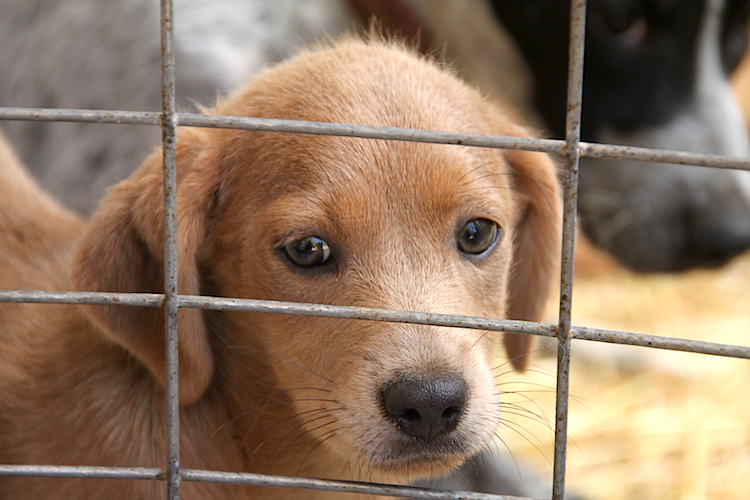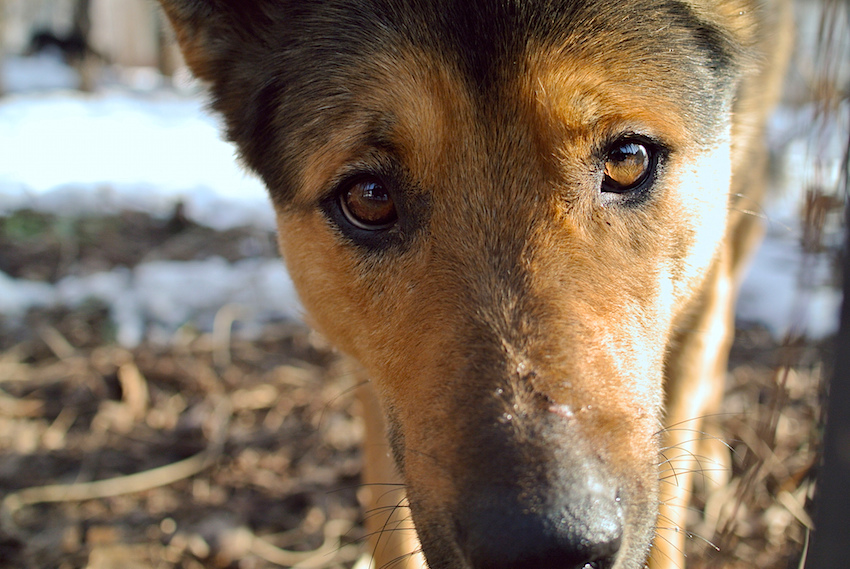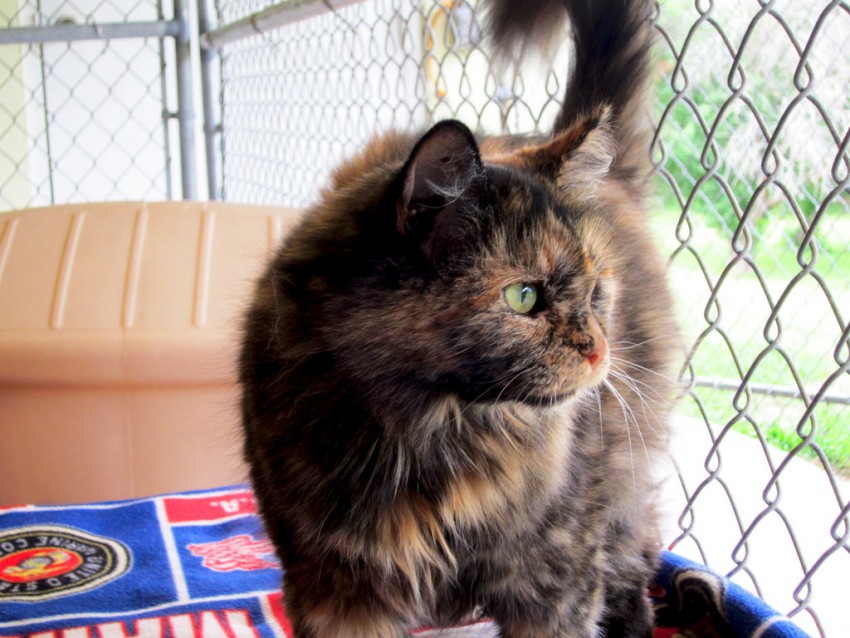
There are thousands of animal shelters in the United States, and you may be considering volunteering with one of them, or possibly even beginning at job there.
You may be wondering what it’s like to work at a shelter.
In this special report from Petful, you’ll read first-hand information from me, a former shelter worker, about what it’s like to work at an animal shelter — both the good and the bad.
Here’s what I’ll cover:
- Part 1: We Can’t Save Them All
- Part 2: The Stray Animal Dilemma
- Part 3: Finding Love in a Shelter Pet
- Part 4: Naming Homeless Pets
- Part 5: Euthanasia and Judgment
Working at an Animal Shelter, Part 1: We Can’t Save Them All
His name was Bingo and he was, as my manager described him, a “cute little button.”
He was also the first dog to attach himself to me during my career at the animal shelter.
Bingo was some sort of miniature sheepdog/schnauzer mix — the kind of “designer” mix that costs thousands. But here he was, homeless at the shelter, pawing at me instead of participating in a temperament test.
Constantly Tempted to Bring Them Home
When I told people I was an animal shelter worker, they often asked, “How do you not take them all home?”
Of course those people were exaggerating, but I’m also restricted to the number of pets in my home by:
- How many I can properly care for
- How many I’m comfortable with handling
- How many I’m legally allowed (many cities have limits)
There is constant temptation to take a pet home when you work with them daily. Regardless of attempts to avoid connecting with the animals, you will form intimate bonds with them. And that temptation will grow stronger. But sentiment and logic have to find a balance when you work with animals.
My response to the inevitable question “How do you not take them all home?” became: “Because I know better.”
I Will Never Forget Bingo
What happened to the mop-haired button dog who wanted to spend every second at my side? A few days after he came in, Bingo caught the attention of a visiting family. They met him, fell immediately in love and adopted him that day.
Bingo walked out of the shelter between 2 skipping children and never came back. But to this day, I still remember him.
Indigo
Bingo may have been the first dog to attach himself to me, but he was hardly the last. Enter Indigo. She was:
- A stray
- A wiggly lovebug
- Great with other pets
- Well behaved
- Overlooked in her kennel
To give her more exposure, we kept her at the front desk for months while looking for her forever home.
But time passed and Indigo began to deteriorate. When it was time for her to go back to her kennel, she refused to walk. She was depressed.
In light of her anxiety, euthanasia became a real concern. If she wasn’t adopted soon, she would be destroyed.
I loved Indigo, but I already had 2 dogs and I just couldn’t imagine taking yet another one.
Was YOUR Pet Food Recalled?
Check Now: Blue Buffalo • Science Diet • Purina • Wellness • 4health • Canine Carry Outs • Friskies • Taste of the Wild • See 200+ more brands…

At the last moment, Indigo was adopted. That day, instead of being dragged back to her kennel, she pranced out of the door as someone’s pet at last!

The Importance of Compatibility
When I say I know better than to take home more pets, I mean that I’ve had more experience with companion animals than most other people.
And from that experience, I’ve learned the following:
Taking home as many animals as possible is not a good idea and is not a solution.
Pet overpopulation is a serious problem. My role was to find homes for the shelter’s animals. Part of that job involved matching pets to compatible adopters.
The Sad Story of Spike
Not all shelter stories have a happy ending. If ever there was a pet I thought I could save, it was Spike.
Spike was a miniature pinscher with a serious ego problem. He hated almost everyone. Except me, that is. He tolerated a few workers, but for some reason Spike chose me as his person.
We kept Spike isolated to try to work on his behavior, but mostly he just sat in my lap or begged for my attention. For weeks his attitude stayed the same, and it became clear that he wasn’t an adoptable dog.
I could have taken Spike home with me. He adored me, and I could have saved his life. But I didn’t. He ended up biting a couple of employees and was ultimately euthanized.
Personal Choices
I don’t regret my decision not to adopt Bingo, Indigo or Spike because I know I made the right choice in all 3 circumstances.
- Bingo was highly adoptable and had no trouble finding a new home.
- Indigo was a perfect dog for me, but I didn’t feel financially or emotionally prepared to have another pet.
- Spike loved me, but he wasn’t compatible with my family. He didn’t care for other dogs and would have been aggressive toward my husband. I wasn’t prepared for that commitment. I’m sorry that he died, yet I don’t hold myself accountable for his fate.
Sure, the temptation can be overwhelming at times while working at a shelter. But knowing what’s best for the animals usually means knowing what’s best for you as well.
And 9 times out of 10, that means not taking them all home.

Working at an Animal Shelter, Part 2: The Stray Animal Dilemma
For at least 48 hours, the name of every stray dog and cat who entered our shelter was either DSTRAY (dog stray) or CSTRAY (cat stray).
And for those 48 hours, we waited hopefully for the dogs’ families to show up and take their pets home.
Sometimes the families came. Sometimes they didn’t.
Below are 3 stories that come to my mind:
1. Max
In the summer of 2006, an unusual stray entered our shelter: a beautiful fawn Boxer.
He had no collar and no microchip, but was neutered and healthy. Somewhere his family was missing him.
Per standard procedure, we situated the Boxer DSTRAY with a cage sign indicating that he was not available for adoption, but was looking for his family. Chances were high that he would be reclaimed before the end of the day.
But he wasn’t.
Boxers are not a common breed in shelters, and the moment DSTRAY was placed in the public view, everyone wanted to know when he would be available for adoption.
We were bullied by people demanding to view him, to “buy” him, to have first “dibs” when he was “for sale.”
Two days later, the Boxer’s person burst through our front doors with a photo of Max dressed in a tuxedo. The woman had been out of town when her dog ran away. That’s why she wasn’t able to claim him immediately.
The photo, she explained, was of Max on her wedding day. He was their best man.
This video features a dog named Denver who was never reclaimed, but he must have had a family because he was so well trained:

2. Panda Blue
During a bad winter storm one year, the animal enforcement officer brought in a peculiar, young Australian Shepherd.
Neutered and recently groomed, he obviously had someone who cared for him, but there was something about this stray that wasn’t quite right.
As with many Australian Shepherds, his eyes were blue, but he didn’t seem to rely on them. In fact, he was unusually disoriented as we led him into the kennel.
He responded to our touches but preferred to huddle, facing a corner of the kennel.
Before we could even enter his information in our system, we received the phone call. This woman had lost her Australian Shepherd. We said we had just received one. She said he is blind and deaf.
We checked our stray again:
- He made no eye contact.
- He didn’t notice our shadows.
- He didn’t respond to noise.
The woman asked, in disbelief, if he had a crescent moon–shaped dark mark on his nose. We confirmed it.
Within minutes, Panda Blue’s mommy was crying over her reunited dog and the confused Aussie was suddenly jumping and howling with excitement.
The woman said she had called every organization she could think of.
3. Toby
My husband and I were driving to meet my in-laws for dinner.
We passed a dead dog on the side of the road — or at least I thought the dog was dead.
“He lifted his head up,” my husband said.
We took the next exit and turned around. The Beagle was still alive when we arrived, but it was nighttime, the highway was busy and the poor thing was at the edge of traffic.
I had to wait, while he bled and suffered, for a moment of safety in between passing semis before I could lunge forward and grab his legs and yank him to me, hoping that he wouldn’t bite, despite my clamping on to his shattered back legs.
I placed him in the trunk of our car and met a shelter manager at a nearby veterinarian’s office. There the Beagle died from his wounds.
The orange nightingale collar is what identified him the next day when Toby’s person reclaimed his dog’s body.

Cats Go Unclaimed More Than Dogs
Happy stories like those of Max and Panda Blue are the ones that kept us positive, but reality is not always so sweet.
Statistically speaking, stray dogs are reclaimed much more frequently than stray cats.
Of the stray cats that enter shelters, less than 5% are reclaimed by their families. The statistic itself is depressing, but the hardest part is seeing stray cats who obviously recently had homes waiting in cages for a family that isn’t coming for them.
You can help change the statistics:
- Always reclaim a lost pet.
- Encourage people to find other means to rehome their unwanted animals than abandoning them.
- Take part in lost-and-found networks on social media.
- Support your local animal shelter.

Working at an Animal Shelter, Part 3: Finding Love in a Shelter Pet
Self-control is an important characteristic of shelter workers — particularly those who don’t want a menagerie of adopted pets at home.
But almost every shelter worker I’ve met has adopted at least 1 pet during his or her shelter career.
The day I was hired, I adopted Ajax.
Ajax
Ajax was a 75-pound American Staffordshire Terrier with a big goofy grin and an even bigger slobbery tongue.
He had an enormous blocky head, broad chest and muscly body. Considering his breed, Ajax was unlikely to be adopted. He was pretty lucky that I got hired that day.
Ajax wasn’t his name — not yet, anyway. In fact, no one really knew his name.
He’d been brought in as a stray who’d had a run-in with a porcupine. With a face full of quills, DSTRAY06-0959 still maintained a positively cheery disposition and shamelessly begged for love from everyone.
DSTRAY06-0959, neutered, healthy and trained, was never reclaimed by his family. The staff dubbed him Bartholomew Quill, and I adopted him.
Getting Comfortable
Ajax was renamed after a Greek mythological hero, and although he did a poor job of slaying Trojan warriors, he did admirably win over our hearts.
My fiancé and I brought Ajax to our apartment before the ink had dried on our lease.
We hadn’t even furnished the whole place yet. But we had a 75-pound dog who insisted on sharing our full-size bed with us.
I adopted Ajax as an adult. Somewhere in his recent past, there was a family and a life that he was used to. There was another bed he slept in and another name he answered to.
Someone else had taken time to raise him.
Ajax:
- Knew basic commands
- Was house-trained
- Didn’t jump up
- Loved belly rubs and sticks
- Cowered when we lifted large objects such as skillets or milk jugs
Someone else had Ajax before us, but they abandoned him when he was an injured stray at a shelter.
Love and Loyalty
For years and years, Ajax helped shape my life.
- He was my couch buddy when I was studying.
- He was there when I graduated from college.
- He was there to celebrate when my fiancé and I were married.
- He helped us move out of our first apartment and into our first house.
- He even moved from a small city in Pennsylvania to the Big Apple with us.
He became the reason we hiked through the woods and walked the beaches in the fall.
He’s why I folded down the back seats of my car to make room for a dog bed. He’s why my family became more fond of less reputable breeds.

Ajax was the clever, sweet dog I had always wanted.
Like so many others, I thought I was taking a chance by adopting him that spring day 9 years ago. But there was never any risk with Ajax.
We fell in love with him — which is why:
- We rolled our eyes when he ate all the fish food one day.
- We just shook our heads when he decided that shredding everything coming from the mail slot was his sworn duty.
- I consoled him after he got into our cupboards, ate enough food to feed a college fraternity for a week and then threw it all up on my feet.
It’s also why we got a second opinion about the inoperable malignant mass on his abdomen.
Final Goodbye
It wasn’t the tumor that killed him.
In fact, the second opinion led to a successful operation that saved his life. His vigor returned with all the weight he had lost to the cancer. For 6 months he regained his old energy and enthusiasm.
And then for 9 months his health rapidly declined:
- From muscle wasting to weakness, he lost the desire to walk.
- Dehydration left him sunken-looking.
- He was moved from 1 medicine to another, treating persistent infections, swelling and pain.
- He was mostly blind and deaf within 3 months.
And then palliative care just wasn’t enough.
Ajax had already died the last time I told him that I loved him. I kissed his cheek and said it as a final goodbye. I told him I loved him all the time. But that was the first time I ever said it as a goodbye.
When I first adopted Ajax, I thought he was lucky that I’d found him. He repaid me with 9 years of unconditional love, memories and happiness. Even in my darkest moments, he was a beacon of light.
Ajax gave me all these things just because I decided to take in the stray no one knew anything about.
It wasn’t Ajax who was lucky the day we met. It was me.

Working at an Animal Shelter, Part 4: Naming Homeless Pets
One of the many jobs of an animal shelter worker is creating new names for adoptable pets.
Although some pets are surrendered with their own names, plenty arrive nameless or with unsuitable names.
In these situations, the staff members come up with new and unique titles for those dogs and cats looking for their forever homes. Whether the names are temporary or more permanent, staff members try to dub their furry shelter friends with fun and loving names.
Stray Animals
Lost, scared and nameless, stray pets are brought to shelters constantly.
Most strays, apart from feral cats and litters, most certainly have a name. And along with that name, they also have a home and a background. But without someone to supply shelter staff with that information, stray pets enter shelters with a clean slate.
Shelters have the job of renaming these castaways and generating a rich description of their personalities from knowing them for only a few days.
It’s a difficult job and unfair to the animals, but also a necessity if they’re ever going to have a chance at adoption.
Common or Inappropriate Names
Sometimes it’s important for shelters and rescues to rename animals because their existing name is too common among the shelter’s pets or because the old name is inappropriate.
Some of the most frequently used names I noticed while working in shelters were:
- Buddy
- Cali
- Smokey
- Midnight
- Momma
When animals came into our shelter with those names, often we’d change them to something similar. Cali became Candy. Buddy became Brodie. Smokey became Loki.
That way, the pets still recognized the sound of their name, and adopters no longer had to clarify which of the 3 dogs named Buddy they wanted more information on.
And when the pets were adopted, the families were always told what their pet’s original name had been, even though adopters frequently chose to change those names regardless.
Shelters will almost always intervene if a pet is dropped off with an inappropriate name. Sometimes those names are meant to be funny or cute, but usually they are harmful to the pet’s adoptability.
Names like these (which were all actual names of dogs) are not appropriate:
- Chaos
- Dummy
- Psycho
For obvious reasons, shelter and rescue staff would rename any pet with a label such as “Dummy” to something more fitting for a loving and happy pup.

Litters
Litters of puppies and kittens who are brought to shelters are usually:
- Strays
- From an accidental litter
- The last few babies who didn’t sell
In most cases, the people surrendering litters haven’t named the puppies or kittens.
That task is left to the staff members who will be caring for them until they find new homes.
Naming litters is different from naming an adult. Puppies and kittens who are only 8 weeks old are generally adopted before they ever hear their name or have a chance to associate it with anything.
The little ones are almost always renamed once they find a new home. Often they’re given silly temporary names while in the shelter — names that follow a theme or are unlikely to be duplicated with one of the other adult animals available for adoption.
Some examples of litter names:
- Eeny, Meeny, Miny and Moe
- John, Paul, George and Ringo
- Bebop, Doowop and Rocksteady
- Parsley, Sage, Rosemary and Thyme
The goofy names add to the lighthearted appeal of the litters and draw more attention from adopters.
Many responsibilities fall on the caretakers at a shelter. Whether the staff members are dubbing a fluffy gray kitten duo Mike and Ike or switching a shepherd’s name from Fang to Copper, they are just trying to increase the appeal of pets to potential adopters.
The end goal is always the same: Find these pets a new loving home.

Working at an Animal Shelter, Part 5: Euthanasia and Judgment
When I was a senior in college, one of my professors noticed one day that I was quieter than usual.
He asked me what was wrong, and I told him that I was preoccupied about work.
When he asked where I worked, I told him the animal shelter and, without missing a beat, he replied, “Oh, you’re just upset because you kill puppies.”
In truth, I was thinking about a fundraising project, so his callous words caught me off guard.
That was my first real moment of understanding what I represented to my community as an animal shelter worker. It was also the first time I realized how overwhelmingly misinformed the public is about shelters.
Shelters Are Symbols of Death
I’m not trying to convince anyone that pets aren’t euthanized in shelters.
They are — every single day. I could argue that healthy animals are rarely killed and that I’ve never seen a single healthy puppy euthanized. But my real issue is who’s being blamed for the death of those pets.
According to my professor, I was to blame.
I was part of an organization that, in his eyes, destroyed innocent, helpless animals. And his comment may have been made somewhat jokingly, but the underlying issue is that animal shelters (and their employees) are symbols of death instead of hope.
Unwanted Pets Outnumber Adopters
Shelters don’t just have animals that they choose to euthanize.
Shelters are given animals. They are forced to accept pets, even when they’ve run out of space.
Communities are overcrowding animal shelters with their unwanted pets. And, because it is their responsibility to house unwanted pets, shelters take the animals that are too “inconvenient” for their families.
Open-access shelters accept all of the animals handed to them, and the staff dedicate themselves, both physically and emotionally, to rehoming pets who have been abandoned or whose novelty has worn off and are no longer wanted.
But every state contains shelters that receive more animals than can be adopted.
That’s when shelter work becomes a horrible math problem — when the number of unwanted pets outstrips the number of adopters, space runs out and pets are euthanized.

The Emotional Toll of Working With Animals
Our society commonly pins the deaths of millions of shelter pets each year on the staff working tirelessly to care for and rehome the animals.
That level of guilt and persecution can be unbearable.
A study by the Journal of Applied Social Psychology reports that “individuals performing animal euthanasia are at increased risk of emotional mismanagement, physical ailments such as high blood pressure and ulcers, unresolved grief, depression, as well as substance abuse and even suicide.”
Shelter employees and volunteers get involved with pets because they love them.
Take my word for it. We grew up adoring animals. We are the ones who will cancel our dates because our dogs aren’t feeling well. We are the ones who feed our cats better food than what we feed ourselves.
Eric Gentry, a Florida psychotherapist, says of shelter workers, “The very thing that makes them great at their work — their empathy and dedication and love for animals — makes them vulnerable.”
The people who are euthanizing shelter pets care the most about them.
Stop Pet Overpopulation at the Source
If we want to stop euthanasia, we can’t focus on the shelters, and we can’t blame the workers.
We must focus on the cause of pet overpopulation and stem that crisis.
This begins with:
- Breeders
- Pet stores
- Puppy mills
We are all responsible for shelter euthanasia. From that friend who didn’t have enough time for her dog and dropped him off at the shelter to the neighbor who won’t pay to spay his cat and gives away her kittens twice a year to the aunt who bought her designer puppy from a pet store to the coworker who insists on buying from a breeder.
And each of us condemning shelters for euthanizing pets and refusing to visit because “it’s just too sad” only hurts the chances for the rest of the animals to find homes.
To end the killing of companion pets, we must all make a real effort:
- Don’t shop — adopt.
- Don’t breed or buy.
- Don’t condemn the shelters that operate at the mercy of your community.
Instead, volunteer, donate and adopt.
Visit the shelter, compliment the staff members for their hard work and encourage the volunteers.
Speak highly of shelters and see the hope that they symbolize — not the tragedy.


